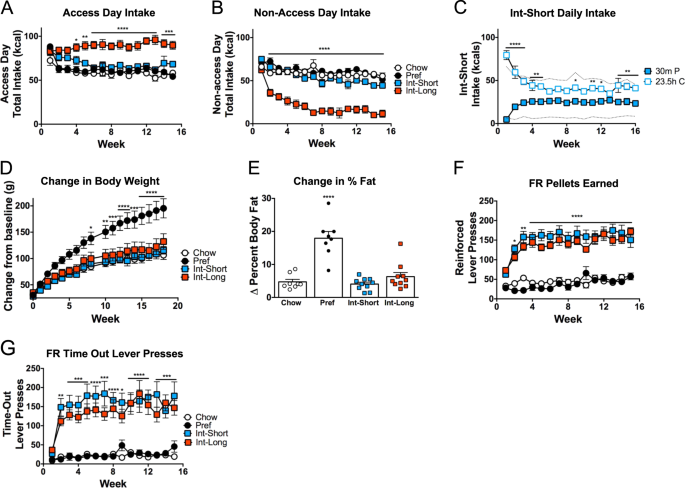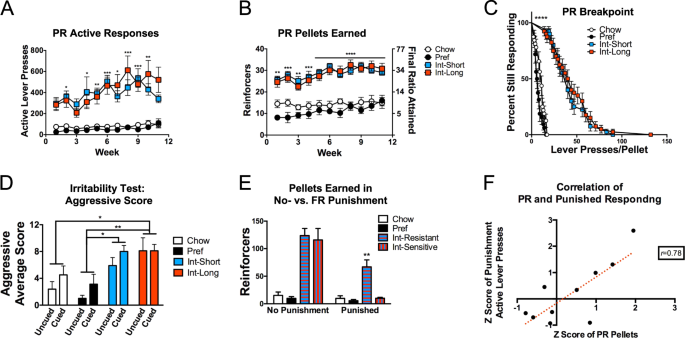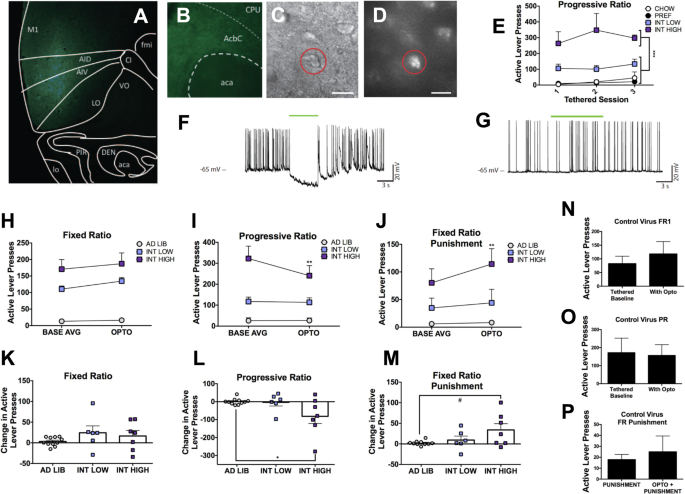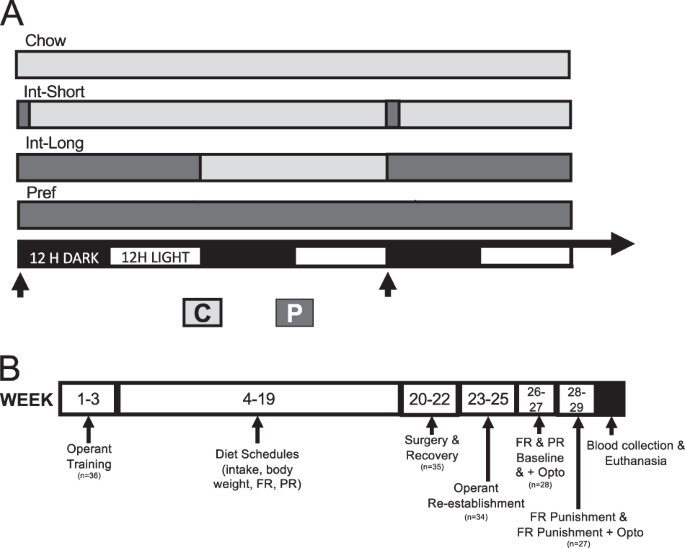Daily energy intake and body weight
To test the hypothesis that rats with intermittent access to the preferred diet would develop food reward tolerance, daily caloric intake was measured. On access days to the preferred diet, Int-Long rats progressively ate more than all other groups (Group × Week: F(42,448) = 3.643, p 0.0001) (Fig. 2a). On days that Int rats received chow only, Int-Long rats progressively under-ate vs. all other groups, stabilizing at levels ~25% of ad lib controls by week 7 (Group × Week: F(42,448) = 4.433, p 0.0001) (Fig. 2b).
Fig. 2
Intake, Body Composition, and Fixed-ratio self-administration. a Int-Long rats have significantly greater food intake during days which they have access to the preferred diet by 4 weeks on the diet schedules compared with all other groups. b Int-Long rats have significantly less food intake by week 2 on days which they have access to the chow diet compared with all other groups. c By week 5, Int-Short rats do not eat significantly different amounts of chow diet in 23.5 h than they do of the preferred diet in 30 min. Dashed lines indicate average consumption of Chow rats during 23.5 h (upper line) and 30 min (lower line). d Pref rats have significantly greater body weight gain compared with all other groups by week 7. e Pref rats gained a significantly greater percentage of body fat by week 16 compared with baseline. f By week 2, both Int groups had significantly more reinforced and g non-reinforced (time-out) active lever presses compared with ad lib groups. *p p p p n = 8–10 per group in each panel
Despite showing normal overall daily intake, Int-Short rats changed how they ate on access days (Diet × Week: F(15, 270) = 14.29, p 0.0001): By 6 weeks, they ate ~40% of their daily intake during 30 min of preferred diet access and had decreased chow intake during the remaining 23.5 h (Fig. 2c).
To test the hypothesis that rats with ad libitum but not intermittent access to the preferred diet have disproportionate weight and fat gain compared with rats with chow access only, as previously reported, weekly body weights and three body composition measurements were taken. Despite having intake similar to Chow rats (Fig. 2a, b), Pref rats gained significantly more weight over time compared with all other groups (Group × Week: F (51,544) = 7.507, p 0.0001) (Fig. 2d) and weighed significantly more at week 16 (Group × Week: F(42,448) = 10.22, p S1C). Pref rats increased percent body fat over 16 weeks (F(3,32) = 25.73, p 2e) while having greater fat mass (F (3,32) = 11.37, p F (3,32) = 1.9994, p = 0.1346) (Fig. S1A-B).
Fixed-ratio operant self administration
To assess the hypothesis that intermittent access would drive increased self-administration behavior in relation to the duration of access, rats were tested under an FR1 reinforcement schedule. Int rats progressively and comparably made more active lever presses (Fig. S1D) than ad libitum (both Chow and Pref) groups (Group × Week: F(42,448) = 4.099, p 0.0001) by week 2 (q’s (480) > 4.86, p’s F(3,32) = 0.2039, p = 0.8929) (Fig. S1E).
More active lever presses reflected that Int rats of both access durations progressively and comparably earned more pellets (Group × Week: F(42,448) = 4.588, p 2f) and had more non-reinforced “timeout” responses (Fig. 2g) than both ad lib fed groups (Group × Week: F(42,448) = 2.588, p F(42,434) = 1.556, p
Progressive-ratio responding
Persistent responding under progressive ratio reinforcement schedules can indicate greater reinforcing efficacy of a substance [46] and, at high ratio requirements, has been proposed to indicate compulsive-like responding wherein responding perseverates despite “incorrect” (nonreinforced) outcomes [37]. To test the hypothesis that INT access promotes increased PR responding, rats were tested under an exponentially increasing progression. Int rats progressively and comparably showed more active lever presses in PR testing vs. both ad lib groups (Group × Week F (30,320) = 1.78, p 0.009) (Fig. 3a) and obtained more reinforcers (pellets) and greater final ratios (Group F(3,32) = 44.13, p 3b). Survival analysis showed that each Int rat persisted lever-pressing beyond all ad lib rats (X2(3) = 183.7, p 3c).
Fig. 3
Progressive and intermittently punished fixed-ratio responding and irritability. a Both Int groups have significantly more active lever presses and b reinforcers earned through greater final ratios attained on the PR schedule compared with ad lib fed rats. c Significant group differences are present in breakpoint (lever presses/pellet) curves among Int and ad lib fed rats. d In the bottle-brush irritability test, both Int groups, regardless of cue/uncued state showed more aggressive responses that Pref rats, and Int-Long rats had more aggressive responses than Chow rats. e A subset (63%) of Int rats termed “Resistant” earned significantly more pellets during FR1 self-administration despite intermittent (FR3) contingent foot shock compared with “Sensitive” Int rats and all ad libs. f Progressive ratio and intermittently punished fixed ratio responding significantly correlate among Int-High rats. *p p p p n = 6–10 per group in each panel
Fixed-ratio punishment responding
Compulsive-like responding also has been operationalized as persistent responding despite adverse outcomes [46]. We therefore tested the hypothesis that INT access would promote continued self-administration despite intermittent punishment. A subset (63%) of Int rats (Int-shock resistant), representing both access durations persist in escalated responding for pellets (2 standard deviations > controls) despite a mild foot shock contingent on every 3rd pellet delivery (Group × Punishment interaction: F(3,29) = 6.565, p 0.002) and had elevated numbers of reinforcers (pellets) earned (Group × Punishment interaction: F(3,29) = 9.639, p t’s(58) > 4.288, p’s S2B & 3E).
Irritability-like behavior
Irritability-like behavior was assessed to test the hypothesis that rats with intermittent but not ad libitum access develop a negative emotional state when they do not have access to the preferred diet, as seen during ethanol withdrawal [34]. When confronted with a spinning bottle brush [34], Int rats showed increased aggressive-like responses toward the brush, irrespective of cue conditions (Group effect F(3,32) = 7.57, p q’s(32) > 4.715, p’s q(32) = 4.498, p 3d). Irrespective of cue conditions, a Group main effect (F(3,32) = 3.212, p q(32) = 3.857, p 0.05) (Fig. S2A).
High vs. low PR rats
In accordance with previous observations [32] and the hypothesis that a subset of rats with intermittent access may be uniquely susceptible to escalated progressive ratio responding for a preferred diet, when rats of both ad lib groups and both Int groups were combined, respectively, a subset of Int rats (54%) showed exacerbated (2 standard deviations > mean of all ad lib rats’ progressive ratio responding (Chow and Pref combined due to statistically comparable behavior, p > 0.99). These rats had with significantly higher PR active lever presses vs. all others (Int-High) (Group effect: F(3,20) = 12.84, p q’s(20) > 5.09, p’s 4e). Both putative measures of compulsive-like self-administration were highly correlated in Int-High rats (PR pellets to Punished active responses: Spearman rho = 0.64; Pearson r = 0.78 p 3f). While the Int-High classification was based on performance during optogenetic tethered control conditions at study end, the escalated PR responding of this subgroup was highly stable and evident weeks earlier in the study (see Fig. S2C&D), similar to our previous reports [32].
Fig. 4
Optoinhibition. Representative images showing a eYFP expression at the anterior insular cortex injection site, b eYFP-labeled fibers in the nucleus accumbens core, and c differential interference contrast image of an d eYFP-labeled neuron for electrophysiology recording. e A subset of intermittent access rats of both diet durations demonstrated significantly elevated progressive ratio active lever presses compared with all other groups, here designated as “Int-High”. f Injected-current-evoked traces showing cessation of neuronal activity in the presence of LED light activation with Arch3.0 T virus. g Injected-current-evoked traces showing no effect in the presence of LED light activation with control virus. In vivo behavioral changes are shown in (h); an overall increase, but no diet specific effects on active lever presses observed in FR1 self-administration in the presence of optoinhibition compared with baseline. i Only Int rats classified as high-responding on PR self-administration show significant decreases in lever pressing in the presence of optoinhibition compared with baseline. j In contrast, the same Int-High responding rats increase lever pressing in the presence of optoinhibition compared with baseline fixed ratio punished FR1. Expressed as the average of individual change in active lever presses with optoinhibition from baseline: there was no significant differences in change in FR active lever presses between groups (k), a decrease of Int-High compared with ad lib PR lever presses (l), and a trend toward an increase of fixed ratio punished active lever presses between Int-High and ad lib rats (m). No significant difference without or with optoinhibition for animals injected with control virus in n FR1 active lever presses, o PR active lever presses, or p fixed ratio punishment active lever presses. *p #p n = 5–10 per group
Behavioral and physiologic correlations
In previous studies, high progressive ratio-responding female rats overate more than Int-Low rats and displayed physiologic differences including a fat-sparing phenotype [32]. To further test the hypothesis that this subset of intermittent access rats with high levels of progressive ratio and intermittently punished responding, also had metabolic adaptations as has been seen in humans with compulsive eating pathologies [39], behavioral and physiologic measures were analyzed for correlation (Table 1) (Supplementary Fig. S3A-F). Uniquely, Int-High rats showed correlation of progressive ratio responding to percent body fat at study onset (week 0) (Spearmanʼs rho = 0.70, Pearsonʼs r = 0.76; p S3A).
Table 1 Behavioral and physiologic correlations were computed for rats of each diet classification
Circulating hormone levels at study end identified Pref rats as having elevated leptin levels (F(3,30) = 9.591, p S4F). Using discriminant function analysis, two unique hormone profiles were identified among all rats: LD1 scores, largely indicating jointly greater leptin and lower ghrelin levels, were greater in Pref rats (F(3,30) = 15.53, p rho’s > 0.68, Pearson r’s > 0.69; p’s F(3,30) = 5.308, p S4E).
Optoinhibition of insula-nucleus accumbens projections
To test the hypothesis that the insula-nucleus accumbens projections modulate compulsive-like responding, optoinhibition of the circuit was performed during operant self-administration sessions. Placement of virus and fiber optics were verified (Fig. 4a, b), and the opsin was validated for inhibitory effect in neurons expressing Arch3.0 T + eYFP or eYFP alone (Fig. 4c, d). In Arch3.0T expressing AIC neurons, light inhibited current-induced action potential frequency from baseline while having no effect in eYFP-only neurons (n = 9; t(4) = 5.528, p 4f, g, also see Fig. S5G &H).
In vivo optoinhibition of CaMKIIa-expressing projections from the AIC-Acb resulted in a descriptively small (~20 lever presses), but reliable, effect of laser optoinhibition (F(1,21) = 6.072, p 4h). The mean increase in active lever presses did not differ between groups (F(2,21) = 1.194, p > 0.3) and was of such small magnitude that no individual group differed from theoretical no change when analyzed individually (p’s > 0.2) (Fig. 4k). Likewise, optoinhibition modestly increased the number of pellets obtained in all groups (F(1,21) = 4.354, p 0.05), but did not reliably alter time out responding (p > 0.13) (Fig. S5 A &B).
In contrast, in the PR paradigm, a significant Group × Laser Condition interaction (F(2,21) = 4.196, p 4i) indicated that “Int-High” rats showed significantly decreased active lever presses during optoinhibition vs. no laser control conditions (t(21) = 3.475, p 0.007); this decrease significantly differed compared with the lack of such a change observed in all ad lib fed rats (t(21) = 2.739, p 4l). Likewise, optoinhibition selectively reduced the breakpoint achieved by Int-High rats (Group × Laser Condition: F (2,21) = 4.631, p 0.022; t(21) = 3.539, p 0.006) (Fig. S5D), but did not reach significance in the resulting number of pellets earned (F(2,21) = 1.914, p > 0.17) (Fig. S5C).
Optoinhibition also elicited modest diet-specific effects on intermittently punished fixed-ratio food self-administration (Group × Laser Condition: F(2,20) = 3.394, p t(20) = 3.564, p 4j). The increase in active lever presses shown by Int-High rats trended higher than the change seen in all ad lib rats (t(20) = 2.556, p 0.056) (Fig. 4m). Optoinhibition resulted in a significantly increased number of pellets earned in the intermittently punished FR self-administration condition overall (Laser main effect: p 0.02) (Fig. S5E) as well as an increase in time out responses during the punished fixed-ratio session that was selectively seen in Int-High rats (Group × Laser Condition: F(2,20) = 4.036, p 0.034; t(20) = 3.725, p 0.005) (Fig. S5F).
In contrast to positive results seen when grouped by progressive ratio performance, effects of optoinhibition did not differ according to assigned groups based on schedule of access to the preferred diet (Int-Short, Int-Long, Chow, Pref) (Fig. S6A-F).
Rats injected with the control virus were not significantly affected by optoinhibition in any reinforcement schedule or outcome measure (Fig. 4n–p & Fig. S7 A-F). Rats with either virus injection anatomical “misses” (n = 4) were not included in any analyses, but descriptively, the rats injected with the opsin virus (n = 3) did not show a similar pattern of opto-induced changes when the laser was on. Rather than a reduction of PR responding, we saw a non-significant mean increase of 24.9 active presses; rather than a modest increase in FR responding, we saw a non-significant mean decrease of 13.3 presses; and on FR punished responding we saw a non-significant mean increase of 24.5 presses.

